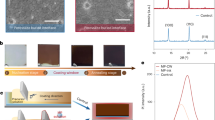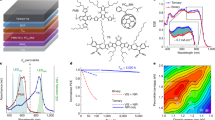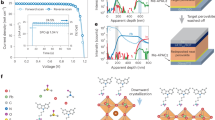Abstract
Flexible perovskite/copper indium gallium selenide (CIGS) tandem solar cells hold great promise for lightweight, high-efficiency applications, yet achieving high-quality perovskite top cells on the rough surfaces of flexible CIGS bottom cells remains challenging. Accordingly, we developed an antisolvent-seeding strategy that decouples self-assembly monolayers (SAMs) adsorption from dissolution, while integrating perovskite seeding. A high-polarity solvent prevents SAMs clustering during dissolution, while a low-polarity antisolvent promotes high-density SAMs formation during adsorption. Additionally, a pre-mixed seed layer further improves perovskite wettability, crystallinity and adhesion. These advancements enable the fabrication of a 1.09-cm2 flexible monolithic perovskite/CIGS tandem with a stabilized efficiency of 24.6% (certified 23.8%), comparable to the best-performing rigid perovskite/CIGS tandems and representing one of the highest efficiencies among flexible thin-film solar cells. The flexible devices also demonstrate excellent durability, retaining over 90% of initial performance after 320 h of operation and 3,000 bending cycles at a 1-cm radius.
This is a preview of subscription content, access via your institution
Access options
Access Nature and 54 other Nature Portfolio journals
Get Nature+, our best-value online-access subscription
$32.99 / 30 days
cancel any time
Subscribe to this journal
Receive 12 digital issues and online access to articles
$119.00 per year
only $9.92 per issue
Buy this article
- Purchase on SpringerLink
- Instant access to full article PDF
Prices may be subject to local taxes which are calculated during checkout





Similar content being viewed by others
Data availability
All data generated or analysed during this study are included in the published article and its Supplementary Information. Any additional information is available from corresponding authors upon request. Source data are provided with this paper.
References
Green, M. A. et al. Solar cell efficiency tables (version 64). Prog. Photovolt.: Res. Appl. 32, 425–441 (2024).
Ying, Z., Yang, X., Wang, X. & Ye, J. Towards the 10-year milestone of monolithic perovskite/silicon tandem solar cells. Adv. Mater. 36, 2311501 (2024).
Keller, J. et al. High-concentration silver alloying and steep back-contact gallium grading enabling copper indium gallium selenide solar cell with 23.6% efficiency. Nat. Energy 9, 467–478 (2024).
Liang, H. et al. 29.9%-efficient, commercially viable perovskite/CuInSe2 thin-film tandem solar cells. Joule 7, 2859–2872 (2023).
Yang, S.-C. et al. Efficiency boost of bifacial Cu(In,Ga)Se2 thin-film solar cells for flexible and tandem applications with silver-assisted low-temperature process. Nat. Energy 8, 40–51 (2023).
Fu, F. et al. High-efficiency inverted semi-transparent planar perovskite solar cells in substrate configuration. Nat. Energy 2, 16190 (2016).
Lang, F. et al. Proton radiation hardness of perovskite tandem photovoltaics. Joule 4, 1054–1069 (2020).
Otte, K., Makhova, L., Braun, A. & Konovalov, I. Flexible Cu(In,Ga)Se2 thin-film solar cells for space application. Thin Solid Films 511–512, 613–622 (2006).
Fu, F. et al. Flexible perovskite/Cu(In,Ga)Se2 monolithic tandem solar cells. Preprint at arXiv https://doi.org/10.48550/arXiv.1907.10330 (2019).
Zheng, J. et al. Efficient flexible monolithic perovskite–CIGS tandem solar cell on conductive steel substrate. ACS Energy Lett. 9, 1545–1547 (2024).
Jeong, I. et al. Flexible and lightweight perovskite/Cu(In,Ga)Se2 tandem solar cells. Joule https://doi.org/10.1016/j.joule.2024.11.011 (2025).
Tian, W. et al. Inert interlayer secures flexible monolithic perovskite/CIGS tandem solar cells with efficiency beyond 21%. ACS Energy Lett. 10, 562–568 (2025).
Tian, L. et al. Divalent cation replacement strategy stabilizes wide-bandgap perovskite for Cu(In,Ga)Se2 tandem solar cells. Nat. Photonics https://doi.org/10.1038/s41566-025-01618-z (2025).
Todorov, T. et al. Monolithic perovskite-CIGS tandem solar cells via in situ band gap engineering. Adv. Energy Mater. 5, 1500799 (2015).
Ruiz-Preciado, M. A. et al. Monolithic two-terminal perovskite/CIS tandem solar cells with efficiency approaching 25%. ACS Energy Lett. 7, 2273–2281 (2022).
Jang, Y. H., Lee, J. M., Seo, J. W., Kim, I. & Lee, D.-K. Monolithic tandem solar cells comprising electrodeposited CuInSe2 and perovskite solar cells with a nanoparticulate ZnO buffer layer. J. Mater. Chem. A 5, 19439–19446 (2017).
Uhl, A. R. et al. Solution-processed low-bandgap CuIn(S,Se)2 absorbers for high-efficiency single-junction and monolithic chalcopyrite-perovskite tandem solar cells. Adv. Energy Mater. 8, 1801254 (2018).
Han, Q. et al. High-performance perovskite/Cu(In,Ga)Se2 monolithic tandem solar cells. Science 361, 904–908 (2018).
Jošt, M. et al. 21.6%-efficient monolithic perovskite/Cu(In,Ga)Se2 tandem solar cells with thin conformal hole transport layers for integration on rough bottom cell surfaces. ACS Energy Lett. 4, 583–590 (2019).
Liu, J. et al. Perovskite-silicon tandem solar cells with bilayer interface passivation. Nature 635, 596–603 (2024).
Jiang, X. et al. Isomeric diammonium passivation for perovskite–organic tandem solar cells. Nature 635, 860–866 (2024).
Wang, Y. et al. Homogenized contact in all-perovskite tandems using tailored 2D perovskite. Nature 635, 867–873 (2024).
Jošt, M. et al. Perovskite/CIGS tandem solar cells: from certified 24.2% toward 30% and beyond. ACS Energy Lett. 7, 1298–1307 (2022).
Al-Ashouri, A. et al. Conformal monolayer contacts with lossless interfaces for perovskite single junction and monolithic tandem solar cells. Energy Environ. Sci. 12, 3356–3369 (2019).
Richardson, J. J., Björnmalm, M. & Caruso, F. Technology-driven layer-by-layer assembly of nanofilms. Science 348, aaa2491 (2015).
Richardson, J. J. et al. Innovation in layer-by-layer assembly. Chem. Rev. 116, 14828–14867 (2016).
Xiao, F.-X., Pagliaro, M., Xu, Y.-J. & Liu, B. Layer-by-layer assembly of versatile nanoarchitectures with diverse dimensionality: a new perspective for rational construction of multilayer assemblies. Chem. Soc. Rev. 45, 3088–3121 (2016).
Park, S. M. et al. Low-loss contacts on textured substrates for inverted perovskite solar cells. Nature 624, 289–294 (2023).
Al-Ashouri, A. et al. Monolithic perovskite/silicon tandem solar cell with >29% efficiency by enhanced hole extraction. Science 370, 1300–1309 (2020).
Li, J. et al. Enhancing the efficiency and longevity of inverted perovskite solar cells with antimony-doped tin oxides. Nat. Energy 9, 308–315 (2024).
Yu, S. et al. Homogenized NiOx nanoparticles for improved hole transport in inverted perovskite solar cells. Science 382, 1399–1404 (2023).
Dai, Z. et al. Interfacial toughening with self-assembled monolayers enhances perovskite solar cell reliability. Science 372, 618 (2021).
Duan, L. et al. Stability challenges for the commercialization of perovskite–silicon tandem solar cells. Nat. Rev. Mater. 8, 261–281 (2023).
Love, J. C., Estroff, L. A., Kriebel, J. K., Nuzzo, R. G. & Whitesides, G. M. Self-assembled monolayers of thiolates on metals as a form of nanotechnology. Chem. Rev. 105, 1103–1170 (2005).
Li, M., Liu, M., Qi, F., Lin, F. R. & Jen, A. K. Y. Self-assembled monolayers for interfacial engineering in solution-processed thin-film electronic devices: design, fabrication, and applications. Chem. Rev. 124, 2138–2204 (2024).
Zhao, Y., Luan, X., Han, L. & Wang, Y. Post-assembled alkylphosphonic acids for efficient and stable inverted perovskite solar cells. Adv. Funct. Mater. 34, 2405646 (2024).
Marcus, Y. & Hefter, G. Ion pairing. Chem. Rev. 106, 4585–4621 (2006).
Dietrich, H. & Zahn, D. Molecular mechanisms of solvent-controlled assembly of phosphonate monolayers on oxide surfaces. J. Phys. Chem. C. 121, 18012–18020 (2017).
Chen, X. et al. Studies on the effect of solvents on self-assembled monolayers formed from organophosphonic acids on indium tin oxide. Langmuir 28, 9487–9495 (2012).
Liu, M. et al. Compact hole-selective self-assembled monolayers enabled by disassembling micelles in solution for efficient perovskite solar cells. Adv. Mater. 35, 2304415 (2023).
Nie, H.-Y., Walzak, M. J. & McIntyre, N. S. Delivering octadecylphosphonic acid self-assembled monolayers on a Si wafer and other oxide surfaces. J. Phys. Chem. B 110, 21101–21108 (2006).
Ito, Y. et al. Crystalline ultrasmooth self-assembled monolayers of alkylsilanes for organic field-effect transistors. J. Am. Chem. Soc. 131, 9396–9404 (2009).
Zheng, X. et al. Co-deposition of hole-selective contact and absorber for improving the processability of perovskite solar cells. Nat. Energy 8, 462–472 (2023).
Tockhorn, P. et al. Nano-optical designs for high-efficiency monolithic perovskite–silicon tandem solar cells. Nat. Nanotechnol. 17, 1214–1221 (2022).
Tang, H. et al. Reinforcing self-assembly of hole transport molecules for stable inverted perovskite solar cells. Science 383, 1236–1240 (2024).
Chen, Y. et al. Self-sacrifice alkali acetate seed layer for efficient four-terminal perovskite/silicon tandem solar cells. Nano Energy 100, 107529 (2022).
Auer, S. & Frenkel, D. Suppression of crystal nucleation in polydisperse colloids due to increase of the surface free energy. Nature 413, 711–713 (2001).
Chen, S. et al. Stabilizing perovskite-substrate interfaces for high-performance perovskite modules. Science 373, 902 (2021).
Boccard, M. & Ballif, C. Influence of the subcell properties on the fill factor of two-terminal perovskite–silicon tandem solar cells. ACS Energy Lett. 5, 1077–1082 (2020).
Fukuda, K. et al. A bending test protocol for characterizing the mechanical performance of flexible photovoltaics. Nat. Energy 9, 1335–1343 (2024).
He, R. et al. Improving interface quality for 1-cm2 all-perovskite tandem solar cells. Nature 618, 80–86 (2023).
Kafedjiska, I. et al. Integration of rough RTP absorbers into CIGS-perovskite monolithic tandems by NiOx(:Cu)+SAM hole-transporting bi-layers. Sol. Energy Mater. Sol. Cells 254, 112248 (2023).
Kafedjiska, I. et al. Disentangling the effect of the hole-transporting layer, the bottom, and the top device on the fill factor in monolithic CIGSe-perovskite tandem solar cells by using spectroscopic and imaging tools. J. Phys. Energy 5, 024014 (2023).
Kafedjiska, I. et al. Advanced characterization and optimization of NiOx:Cu-SAM hole-transporting bi-layer for 23.4% efficient monolithic Cu(In,Ga)Se2-perovskite tandem solar cells. Adv. Funct. Mater. 33, 2302924 (2023).
Geng, C. et al. Crystallization modulation and holistic passivation enables efficient two-terminal perovskite/CuIn(Ga)Se2 tandem solar cells. Nano Micro Lett. 17, 8 (2025).
Yan, B. et al. Innovative dual function nc-SiOx:H layer leading to a >16% efficient multi-junction thin-film silicon solar cell. Appl. Phys. Lett. 99, 113512 (2011).
Mahabaduge, H. P. et al. High-efficiency, flexible CdTe solar cells on ultra-thin glass substrates. Appl. Phys. Lett. 106, 133501 (2015).
Hwang, I., Um, H.-D., Kim, B.-S., Wober, M. & Seo, K. Flexible crystalline silicon radial junction photovoltaics with vertically aligned tapered microwires. Energy Environ. Sci. 11, 641–647 (2018).
Sun, Y. et al. Flexible organic photovoltaics based on water-processed silver nanowire electrodes. Nat. Electron. 2, 513–520 (2019).
Li, Z. et al. Hybrid perovskite–organic flexible tandem solar cell enabling highly efficient electrocatalysis overall water splitting. Adv. Energy Mater. 10, 2000361 (2020).
Yang, K.-J. et al. Sodium effects on the diffusion, phase, and defect characteristics of kesterite solar cells and flexible Cu2ZnSn(S,Se)4 with greater than 11% efficiency. Adv. Funct. Mater. 31, 2102238 (2021).
Li, L. et al. Flexible all-perovskite tandem solar cells approaching 25% efficiency with molecule-bridged hole-selective contact. Nat. Energy 7, 708–717 (2022).
Flexible Solar Cells with Record Efficiency of 22.2% (Empa, 2022); https://www.empa.ch/web/s604/solarzellen-rekord?inheritRedirect=true
Liang, X. et al. High-efficiency flexible Sb2Se3 solar cells by back interface and absorber bulk deep-level trap engineering. ACS Energy Lett. 8, 213–221 (2023).
Zheng, X. et al. Versatile organic photovoltaics with a power density of nearly 40 W g−1. Energy Environ. Sci. 16, 2284–2294 (2023).
Song, W. et al. Ultra robust and highly efficient flexible organic solar cells with over 18% efficiency realized by incorporating a linker dimerized acceptor. Angew. Chem. Int. Ed. 62, 202310034 (2023).
Ren, N. et al. 25%-Efficiency flexible perovskite solar cells via controllable growth of SnO2. iEnergy 3, 39–45 (2024).
Wang, X. et al. Ultrathin (∼30 µm) flexible monolithic perovskite/silicon tandem solar cell. Sci. Bull. 69, 1887–1894 (2024).
Gong, C. et al. An equalized flow velocity strategy for perovskite colloidal particles in flexible perovskite solar cells. Adv. Mater. 36, 2405572 (2024).
Acknowledgements
J.Y. acknowledges financial supports from the National Key Research and Development Program of China (grant number 2024YFB3817304), Baima Lake Laboratory Joint Funds of the Zhejiang Provincial Natural Science Foundation of China (grant number LBMHD24E020002). Z.Y. acknowledges financial support from the National Natural Science Foundation of China (grant number 62204245) and Zhejiang Provincial Natural Science Foundation of China (grant number LY24F040003). X.Y. acknowledges financial support from the National Natural Science Foundation of China (grant number U23A200098), Key Research and Development Program of Zhejiang Province (grant numbers 2022C01215, 2024C01092, 2025C01154), Key Research and Development Program of Ningbo (grant numbers 2023Z151, 2024QL037). We thank Shenzhen HUASUAN Technology Co., Ltd. for the assistance with the theoretical calculations.
Author information
Authors and Affiliations
Contributions
Z.Y., X.Y. and J.Y. contributed to the conceptualization, project administration, funding acquisition, original draft writing, review and editing. X.Y. and J.Y. contributed to the supervision. Z.Y., X.Y., C.Z. and J.Y. conducted the investigation. Z.Y., X.Y. and C.Z. were responsible for the methodology. Z.Y., S.S., X.L., G.C., C.L., D.L., M.Z., X.G., H.T., Y.S., L.L., C.X. and Y.Z. contributed to the visualization.
Corresponding authors
Ethics declarations
Competing interests
The authors declare no competing interests.
Peer review
Peer review information
Nature Energy thanks Alex Jen, Jianghui Zheng, and Jun Yin for their contribution to the peer review of this work.
Additional information
Publisher’s note Springer Nature remains neutral with regard to jurisdictional claims in published maps and institutional affiliations.
Supplementary information
Supplementary Information
Supplementary Notes 1–15, Figs. 1–72 and Tables 1–8.
Supplementary Data
Statistical source data for Supplementary Figs. 51 and 60.
Source data
Source Data Fig. 1
Source data for Fig. 1b,c.
Source Data Fig. 3
Source data for Fig. 3b,c,f,i.
Source Data Fig. 4
Source data for Fig. 4b–d and g–i.
Source Data Fig. 5
Source data for Fig. 5c–i.
ChemDraw file Fig. 1a
ChemDraw file for Fig. 1a.
Rights and permissions
Springer Nature or its licensor (e.g. a society or other partner) holds exclusive rights to this article under a publishing agreement with the author(s) or other rightsholder(s); author self-archiving of the accepted manuscript version of this article is solely governed by the terms of such publishing agreement and applicable law.
About this article
Cite this article
Ying, Z., Su, S., Li, X. et al. Antisolvent seeding of self-assembled monolayers for flexible monolithic perovskite/Cu(In,Ga)Se2 tandem solar cells. Nat Energy 10, 737–749 (2025). https://doi.org/10.1038/s41560-025-01760-6
Received:
Accepted:
Published:
Issue date:
DOI: https://doi.org/10.1038/s41560-025-01760-6



